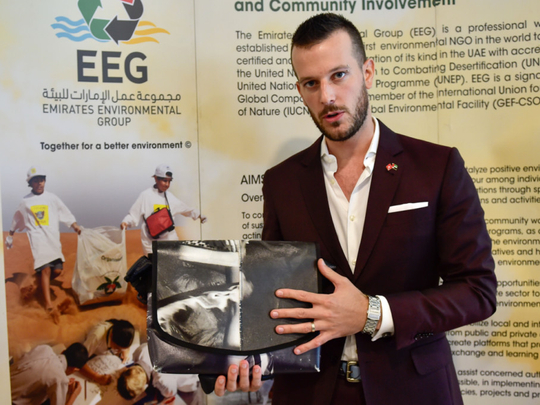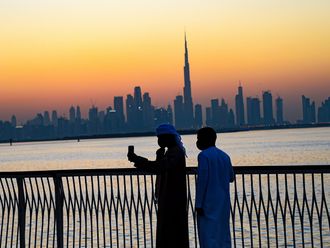
Dubai: This Italian-made handbag used to be on display — literally — on Shaikh Zayed Road as part of a huge billboard.
Matteo Boffa, general manager and co-founder of Etuix, sequestered the material and turned the giant billboard made out of Polyvinyl Chloride (PVC) or vinyl into handbags, shoes, trolleys, wallets, and belts.
PVC is all around us. It’s the third largest thermoplastic material by volume, that if not recycled or reused, would pose a huge problem to the environment.
In Dubai alone, more than 1 million square metres of PVC are produced every year and more than 500,000kg of PVC material destroyed per year, Boffa said. “The high cost of renting advertising space on Shaikh Zayed Road — Dh18 million per year for one good spot — [is cost prohibitive] for many companies, that is why they rent space for a short term. This results in a high turnover of PVCs,” Boffa said.
Boffa decided to take the material and “breathe new life” into it and make it last 10 more years, instead of letting it end up in the landfill.
What Boffa did is a practical example of adopting a circular economy, where society does away with the take-make-dispose culture and instead brings waste full circle.
This shift in the economic model is doable and commercially viable even in the UAE, said panellists of the Emirates Environmental Group’s (EEG) fourth Panel Discussions on Wednesday. It only takes motivation, effort, and a change in mindset, EEG chairperson Habiba Al Marashi said.
Recycle-reuse-reduce
“Circular economy is definitely a paradigm shift in how people are conducting their business operations. It’s a very simple common sense approach,” Al Marashi said.
She stressed there should be efficient management of shared natural resources and safe disposal of toxic waste and pollutants. Currently, 66 per cent of the total waste generated in the UAE is disposed in the landfill. “To make a circular economy work, that 66 per cent should not go to landfills. Landfills should be null and void,” Al Marashi said.
To prove that this can be done with everyone’s contribution, speakers representing the industrial sector, environmental consulting firms and the remanufacturing industry presented their best practices and success stories in implementing the circular economy in Dubai.
Emirates Global Aluminium (EGA), for example, has found a way to recycle its Spent Potlining (SPL), a hazardous waste material generated when producing aluminium. EGA generates 33,000 metric tonnes of SPL every year.
By adopting a recycle-reuse-reduce philosophy, EGA recycled over 96,000 tonnes of waste, up from over 77,000 tonnes in 2016. “This is a clear, evident part of circular economy where we take ownership of our waste or our by-products until the end of treatment,” said panellist Heba Saleh Abdul Hamid Akasha from Environment and Waste Management at EGA.
Another example would be the simple act of remanufacturing ink cartridges, said Dr Sassan Khatib-Shahidi, co-founder and CEO of German Imaging Technologies Dubai. “It takes 20 times more energy to make a new cartridge than to reuse one. One hundred per cent of what comes to us does not go to waste: 80 per cent is reused while 20 per cent is recycled,” the panellist said.
“Our remanufacturing has resulted in Dh100 million savings for our clients over the years. It has also helped society by creating more jobs. It helped the environment and there is less waste disposed in landfills. This way, everybody wins.”
■ Each person in the UAE produces 1.8kg of waste per day
■ 66% of total waste generated goes to landfills
■ More than 1 million square metres of PVC produced in Dubai every year
■ More than 500,000kg of PVC material destroyed every year in Dubai












